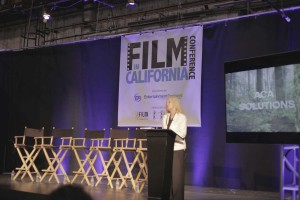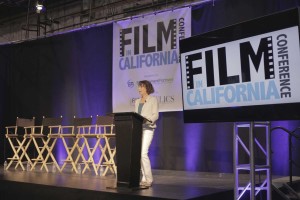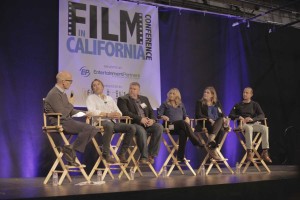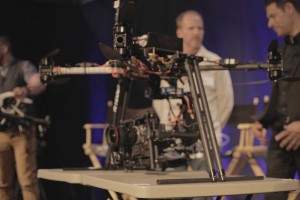
Content creators of all budget sizes gathered on the CBS backlot June 13 for the 8th annual Film in California Conference. Film offices from various cities and counties in California filled the stage nine floor with exhibits to showcase the visual and financial benefits of keeping production in the golden state.
Janice Arrington, president of Film Liaisons in California Statewide (FLICS), introduced the day’s schedule and talked about the collaborative dynamic between FLICS and the California Film Commission (CFC). “Our goal is to make production boom permanently in the golden state,” said Arrington.

Amy Lemisch, executive director of CFC, presented keynote speaker and actor Joe Mantegna, and introduced each panel discussion. Additionally, Lemisch talked about the CFC’s ongoing efforts to bring production back to California, as well as reasons supporting California as the ideal state for motion picture and television. “(We have) locations that are so diverse you can shoot snow-capped mountains and a dry, desolate desert in the same day, then go home and sleep in your own bed at night,” said Lemisch. She offered insight to the developing film and television tax credit program, explaining that its latest phase, 2.0, “expanded funding from $100 million a year to $330 million, expanded eligibility to include big-budget feature films and one-hour television series for any distribution outlet, and even pilots. It also eliminated the budget caps for big budget films and independent projects. It replaced the lottery system with the new ranking system, based on jobs and other criteria. It added additional 5% tax credits for certain expenditures like filming out of the zone, visual effects and music expenditures. It created four separate dedicated funding pots: TV projects, relocated TV series, independent projects and non-independent features.” Lemisch also led a workshop on the tax credit program as the closing seminar for the conference.
Mantegna’s keynote address provided an industry veteran’s perspective on the importance of boosting production in Hollywood. Mantegna reflected on turning down roles which would require him to relocate, stressing the state’s geographic versatility and pampering climate. “Every night I get to go home. There’s a reason why this is home. Not just for me, not just for you, there’s a reason why film pioneers chose this place,” expressed Mantegna. “We’ve done a pretty damn good job over the last 10 years of duplicating all 50 states in the United States shooting in a 50 mile radius,” he added, regarding Criminal Minds, for which he plays David Rossi.

Director and chief liaison of the Mayor’s Office of Film and Television Production Kevin James took to the stage to share his and the mayor’s shared mission of accessibility and dedication to productions of all sizes. “My goal is to spend one day per week at the FilmLA offices,” said James. “Over time, the industry that works with me on a number of the challenges they face in the city of Los Angeles, they’ll know where and when they can find me. That doesn’t mean that’s the only time they can get me, I’m working on film and television industry issues every day of the week, including Saturday and Sunday.” Additionally, James explained updates in fee structures and policies related to shooting in the city of Los Angeles.
The Premiere Producers Panel, entitled “California: The Gold Standard,” featured Gregg Feinberg, executive producer, True Blood; Jim Kleverweis, line producer, Togetherness; Betsy Megel, VP of physical production on feature films produced by Paramount Pictures; Marcy Patterson, co-producer, Mad Men; Michael Zakin, executive producer of Eleanor Coppola’s debut feature Bonjoure Anne, and was moderated by John Horn, host of KPCC’s The Frame. The collective of producers addressed the developing tax incentive program, and its weight in the decision process of shooting in or leaving the golden state. “If creatively it works in California, we want to be in California, provided we can get the incentive,” said Megel. “Once you get into higher budgeted films, it’s very challenging cost wise to match the incentives that are available in Georgia and New Orleans if you don’t have an incentive in California. The only way to keep those home anymore is really with an incentive, but we’re constantly trying to keep those home.” The panel also collectively stressed California as the most convenient state for duplicating other states and unique locations.
 The “Elevate Your Production with Drones” panel featured technologist and International Cinematographers Guild representative Michael Chambliss; CEO and co-founder of the Tesla Foundation Keith Kaplan, and owner and chief pilot of Vortex Aerial, Chris Schuster. Discussed were the advantages of drone technology in film production, both budgetary and artistic, as well as the path drone technology has taken thus far and to what heights it may soon reach. “It’s a new vernacular in the language of cinematography,” said Chambliss. He explained the handheld look of the 1960s, inspired by smaller camera design, as well as the steady cam look of the 1970s with the development of body-mounted rigs, and how such technological advancements inspired scripts and cinematic style for the respective periods. “These drones are going to do very much the same thing. Right now, we’re in the early stages and starting to discover how to work with them. There are things we have never before been able to bridge, with spontaneous movement between four feet off the ground and 400 feet off the ground. This is a brand new thing in movie making.” The panel also discussed California regulation of drone piloting for film and television. “The individual that goes out and buys a drone as a hobbyist has the ability to have the perspective of a bird, but they have to be educated on the fact that this is an aircraft,” said Kaplan.
The “Elevate Your Production with Drones” panel featured technologist and International Cinematographers Guild representative Michael Chambliss; CEO and co-founder of the Tesla Foundation Keith Kaplan, and owner and chief pilot of Vortex Aerial, Chris Schuster. Discussed were the advantages of drone technology in film production, both budgetary and artistic, as well as the path drone technology has taken thus far and to what heights it may soon reach. “It’s a new vernacular in the language of cinematography,” said Chambliss. He explained the handheld look of the 1960s, inspired by smaller camera design, as well as the steady cam look of the 1970s with the development of body-mounted rigs, and how such technological advancements inspired scripts and cinematic style for the respective periods. “These drones are going to do very much the same thing. Right now, we’re in the early stages and starting to discover how to work with them. There are things we have never before been able to bridge, with spontaneous movement between four feet off the ground and 400 feet off the ground. This is a brand new thing in movie making.” The panel also discussed California regulation of drone piloting for film and television. “The individual that goes out and buys a drone as a hobbyist has the ability to have the perspective of a bird, but they have to be educated on the fact that this is an aircraft,” said Kaplan.
To close out the 2015 Film In California Conference, a wine and craft beer mixer was hosted by the exhibitors, encouraging guests to mingle and network.





